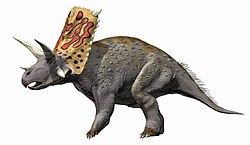| Javelina Formation | |
|---|---|
| Stratigraphic range: Maastrichtian, | |
 Distinctive mauve and red beds of the Javelina Formation outcropping in Big Bend National Park, Texas | |
| Type | Geological formation |
| Unit of | Tornillo Group |
| Underlies | Black Peaks Formation |
| Overlies | Aguja Formation |
| Lithology | |
| Primary | Sandstone |
| Other | Claystone, mudstone, siltstone, conglomerate |
| Location | |
| Coordinates | 29°18′N103°24′W / 29.3°N 103.4°W |
| Approximate paleocoordinates | 36°00′N82°48′W / 36.0°N 82.8°W |
| Region | Texas |
| Country | United States |
| Type section | |
| Named for | Javelina |
The Javelina Formation is a geological formation in Texas. Dating has shown that the strata date to the Maastrichtian stage of the Late Cretaceous, approximately 70 to 66.5 million years old. [1] The middle part of the formation has been dated to about 69 million years ago plus or minus 1 million years and the top situated near the Cretaceous–Paleogene boundary (in the overlying Black Peaks Formation [1] ), dated to 66 Ma ago. [2] Dinosaur remains are among the fossils that have been recovered from the formation. [3]













